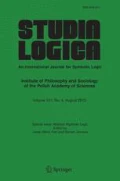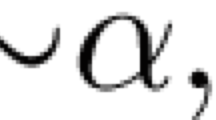Abstract
Paradefinite (‘beyond the definite’) logics are logics that can be used for handling contradictory or partial information. As such, paradefinite logics should be both paraconsistent and paracomplete. In this paper we consider the simplest semantic framework for introducing paradefinite logics. It consists of the four-valued matrices that expand the minimal matrix which is characteristic for first degree entailments: Dunn–Belnap matrix. We survey and study the expressive power and proof theory of the most important logics that can be developed in this framework.
Similar content being viewed by others
References
Anderson, A., and N. Belnap, Entailment, vol. 1. Princeton University Press, Princeton, 1975.
Arieli, O., Paraconsistent reasoning and preferential entailments by signed quantified Boolean formulae, ACM Transactions on Computational Logic 8(3), 2017. doi:10.1145/1243996.1244001.
Arieli, O., and A. Avron, Reasoning with logical bilattices, Journal of Logic, Language, and Information 5(1):25–63, 1996.
Arieli, O., and A. Avron, The value of the four values, Artificial Intelligence 102(1):97–141, 1998.
Arieli, O., and A. Avron, Bilattices and paraconsistency, in D. Batens, C. Mortensen, G. Priest and J. Van Bendegem (eds.), Frontiers of Paraconsistent Logic, vol. 8 of Studies in Logic and Computation, Research Studies Press, London, 2000, pp. 11–27.
Arieli, O., and A. Avron, Three-valued paraconsistent propositional logics, in J. Y. Béziau, M. Chakraborty and S. Dutta (eds.), New Directions in Paraconsistent Logic, Springer, Berlin, 2015, pp. 91–129.
Arieli, O., and A. Avron, Minimal paradefinite logics for reasoning with incompleteness and inconsistency, in Proceedings of the 1st International Conference on Formal Structures for Computation and Deduction (FSCD), vol. 52 of Leibniz International Proceedings in Informatics, 2016, pp. 7:1–7:15.
Arieli, O., A. Avron, and A. Zamansky, Ideal paraconsistent logics, Studia Logica 99(1–3):31–60, 2011.
Arieli, O., A. Avron, and A. Zamansky, Maximal and premaximal paraconsistency in the framework of three-valued semantics, Studia Logica 97(1):31–60, 2011.
Arieli, O., and M. Denecker, Reducing preferential paraconsistent reasoning to classical entailment, Journal of Logic and Computation 13(4):557–580, 2003.
Asenjo, F. G., A calculus of antinomies, Notre Dame Journal of Formal Logic 7:103–106, 1966.
Avron, A., Natural 3-valued logics: characterization and proof theory, Journal of Symbolic Logic 56(1):276–294, 1991.
Avron, A., On the expressive power of three-valued and four-valued languages, Journal of Logic and Computation 9(6):977–994, 1999.
Avron, A., Paraconsistency, paracompleteness, gentzen systems, and trivalent semantics, Journal of Applied Non-Classical Logic 24:12–34, 2014.
Avron, A., J. Ben-Naim, and B. Konikowska, Processing information from a set of sources, in D. Makinson, J. Malinowski and H. Wansing (eds.), Towards Mathematical Philosophy, Trends in Logic, vol. 10, Springer, 2009, pp. 165–186.
Avron, A., and B. Konikowska, Multi-valued calculi for logics based on non-determinism, Logic Journal of the IGPL 13(4):365–387, 2005.
Avron, A., and B. Konikowska, Finite-valued logics for information processing, Fundamenta Informaticae 114:1–30, 2012.
Avron, A., B. Konikowska, and A. Zamansky, Cut-free sequent calculi for C-systems with generalized finite-valued semantics, Journal of Logic and Computation 23:517–540, 2013.
Avron, A., and I. Lev, Non-deterministic multi-valued structures, Journal of Logic and Computation 15:241–261, 2005.
Avron, A., and A. Zamansky, Non-deterministic semantics for logical systems—a survey, in D. Gabbay and F. Guenther (eds.), Handbook of Philosophical Logic, vol. 16, Springer, Berlin, 2011, pp. 227–304.
Belnap, N., How a computer should think, in G. Ryle (ed.), Contemporary Aspects of Philosophy, Oriel Press, Stocksfield, 1977, pp. 30–56.
Belnap, N., A useful four-valued logic, in J. M. Dunn and G. Epstein (eds.), Modern Uses of Multiple-Valued Logics, Reidel Publishing Company, Dordrecht, 1977, pp. 7–37.
Béziau, J. Y., Bivalent semantics for De Morgan logic (The uselessness of four-valuedness), in W. A. Carnielli, M. E. Coniglio and I. M. L. D’Ottaviano (eds.), The Many Sides of Logic, College Publication, London, 2009, pp. 391–402.
Bimbo, K., and M. Dunn, Four-valued logic, Notre Dame Journal of Formal Logic 42(3):171–192, 2001.
Bou, F., and U. Rivieccio, The logic of distributive bilattices. Logic Journal of the IGPL 19(1):183–216, 2010.
da Costa, N., On the theory of inconsistent formal systems, Notre Dame Journal of Formal Logic 15:497–510, 1974.
De, M., and H. Omori, Classical negation and expansions of Belnap-Dunn logic, Studia Logica 103(4):825–851, 2015.
Doherty, P., D. Driankov, and A. Tsoukiàs, Partiality, para-consistency and preference modelling, 1992. IDA Research report Lith-IDA-R-92-18, Linköping University.
D’Ottaviano, I., The completeness and compactness of a three-valued first-order logic, Revista Colombiana de Matematicas XIX(1-2):31–42, 1985.
Dunn, J. M., The Algebra of Intensional Logics. Ph.D. thesis, University of Pittsburgh, Ann Arbor (UMI), 1966.
Dunn, J. M., Intuitive semantics for first-degree entailments and ‘coupled trees’, Philosophical Studies 29:149–168, 1976.
Epstein, R. L., The Semantic Foundation of Logic. Vol. I: Propositional Logics. Kluwer, Dordrecht, 1990.
Fitting, M., Bilattices and the semantics of logic programming, Journal of Logic Programming 11(2):91–116, 1991.
Fitting, M., The family of stable models, Journal of Logic Programming 17:197–225, 1993.
Fitting, M., Fixpoint semantics for logic programming a survey, Theoretical Computer Science 278(1-2):25–51, 2002.
Fitting, M., Bilattices are nice things, in T. Bolander, V. Hendricks and S. A. Pedersen (eds.), Self Reference, vol. 178 of CSLI Lecture Notes, CLSI Publications, Stanford, 2006, pp. 53–77.
Font, J. M., and P. Hájek, On Łukasiewicz’s four-valued modal logic, Studia Logica 70(2):157–182, 2002.
Gabbay, D., and H. Wansing, (eds.), What is Negation?, vol. 13 of Applied Logic Series, Springer, Berlin, 1999.
Gargov, G., Knowledge, uncertainty and ignorance in logic: bilattices and beyond, Journal of Applied Non-Classical Logics 9(2-3):195–283, 1999.
Gentzen, G., Investigations into logical deduction, 1934, in M. E. Szabo (ed.), German. An English translation appears in ‘The Collected Works of Gerhard Gentzen’, Noth Holland Publishing Company, 1969.
Ginsberg, M., Multi-valued logics, in Ginsberg, M. L. (ed.), Readings in Non-Monotonic Reasoning, Morgan Kaufmann, Los Altos, 1988, pp. 251–258.
Ginsberg, M., Multi-valued logics: a uniform approach to reasoning in AI, Computer Intelligence 4:256–316, 1988.
Gottwald, S., A treatise on many-valued logics, in S. Gottwald (ed.), Studies in Logic and Computation, vol. 9. Research Studies Press, Baldock, 2001.
Malinowski, G., Many-Valued Logics, Clarendon Press, NY, 1993.
Marcos, J., On negation: Pure local rules, Journal of Applied Logic 3(1):185–219, 2005.
Odintsov, S. P., and H. Wansing, The logic of generalized truth values and the logic of bilattices, Studia Logica 103(1):91–112, 2015.
Priest, G., Reasoning about truth, Artificial Intelligence 39:231–244, 1989.
Priest, G., Minimally inconsistent LP, Studia Logica 50:321–331, 1991.
Restall, G., Four-valued semantics for relevant logics (and some of their rivals), Journal of Philosophical Logic 24:139–160, 1995.
Shoesmith, D. J., and T. J. Smiley, Deducibility and many-valuedness, Journal of Symbolic Logic 36:610–622, 1971.
Shoesmith, D. J., and T. J. Smiley, Multiple Conclusion Logic, Cambridge University Press, NY, 1978.
Takeuti, G., Proof Theory, Dover, NY, 2013.
Troelstra, A. S., and H. Schwichtenberg, Basic Proof Theory, Cambridge University Press, NY, 2000.
Tsoukiàs, A., A first-order, four valued, weakly paraconsistent logic and its relation to rough sets semantics, Foundations of Computing and Decision Sciences 27:77–96, 2002.
Urquhart, A., Many-valued logic, in D. Gabbay and F. Guenthner (eds.), Handbook of Philosophical Logic, vol. II, Second edition, Kluwer, Dordrecht, 2001, pp. 249–295.
Visser, A., Four-valued semantics and the liar, Journal of Philosophical Logic 13:181–212, 1984.
Author information
Authors and Affiliations
Corresponding author
Rights and permissions
About this article
Cite this article
Arieli, O., Avron, A. Four-Valued Paradefinite Logics. Stud Logica 105, 1087–1122 (2017). https://doi.org/10.1007/s11225-017-9721-4
Published:
Issue Date:
DOI: https://doi.org/10.1007/s11225-017-9721-4



